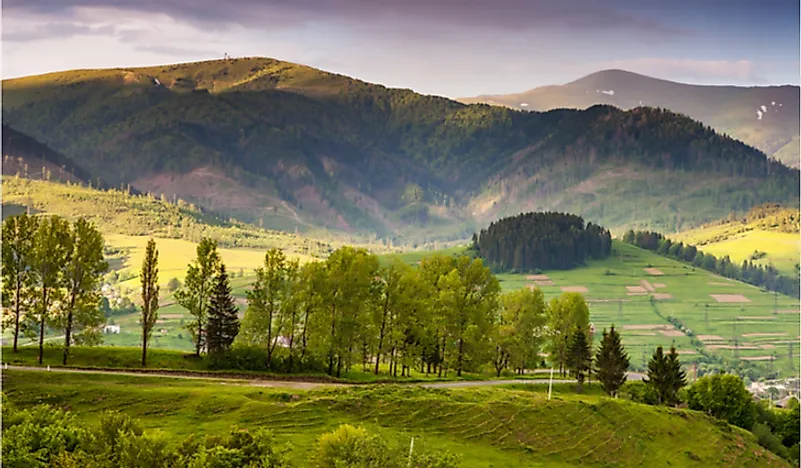What Type Of Climate Does Ukraine Have?

Ukraine is a country in eastern Europe. The majority of the nation's landscape is plains with an average elevation of 574 feet above sea level. Areas with mountainous landscape such as the Crimean Mountains and the Ukrainian Carpathians are only found near the borders and account for about 5% of the nation’s total area.
The nation's plains are divided by highlands that run from the northwest to the southwest and by lowlands. The plains of the Dnieper Upland in the west-central part of the country make up the largest highland. It contains numerous river valleys, gorges, and ravines.
The rugged Voly-Podilsk Upland that rises to 1,545 feet is to the west of the Dnieper Upland. The Carpathian Mountains extend for about 150 miles and rise to an elevation of between 2,000 feet and 6,500 feet. The highest point in the country is Mount Hoveria which rises to 6,762 feet. The southeastern and northeastern parts of the country mainly consist of low uplands. The landscape to the north is lowlands such as the Pripet Marshes. The Dnieper lowland is found in east-central Ukraine while the southern valley extends along the shores of the Black Sea.
Climate Of Ukraine
Ukraine is in a temperate climatic zone that is influenced by humid and moderately warm air masses originating from the Atlantic Ocean. According to the Koeppen-Geiger classification, the country has a Dfb climate which is a humid snow climate. The average temperatures in the warmest month are between 50 and 71.6-degree Fahrenheit while the coldest months experience temperatures of 26.6 degrees Fahrenheit and 50 degrees Fahrenheit.
In the eastern inland area, the climate is classified as Bsk which is characterized by cold and dry weather, the summers are dry, and the average annual temperatures are less than 64.4 degrees Fahrenheit. The coastal regions of the Black Sea have a Cfa climate which is characterized by a humid, warm temperate climate. Generally, the weather is dry and continental with warm and dry summers and relatively severe winters. The summers become progressively warmer towards the south. Areas overlooking the Black Sea to the south have milder weather during winter.
Precipitation
The precipitation in the country occurs quite frequently but is however not abundant in many areas of the country. The vast inland areas which are occupied by hills and plains receive average annual precipitation of between 20 and 23.5 inches. Summer is the rainiest season due to afternoon thunderstorms. The winter season is not dry and experiences frequent precipitation in the form of light snow. In areas bordering the Black Sea precipitation is not as prevalent and is below 20 inches annually. During summer, thunderstorms are rare. The rainiest regions in the country are the Carpathian Mountains and the Crimean Mountains.
In the Carpathian Mountains, the precipitation reaches about 47 inches in a year while the Crimean Mountains receive about 40 inches in a year. Some regions to the west of the Carpathian Mountains receive about 27.5 inches of precipitation per year. During winter, gray skies are prevalent with the sun barely shining. During summer the sun often shines especially on the shores of the Black Sea.
Spring
During spring the sunshine hours and temperatures are relatively higher. Snow melts in the continental areas in March and turns into mud, making traveling on rural roads difficult. At the beginning of April warm days are experienced following the return of cold weather which has occasional frost and snow. During May, the temperatures become more pleasant especially in the latter period of the month.
Summer
The Ukranian summer is quite sunny and warm and at times experiences thunderstorms in the central and northern region. The highest temperatures happen in July, reaching 79 degrees Fahrenheit in the north and 77-degree Fahrenheit in the far north. In southern areas and coastal areas of the Black Sea temperatures reach 81 or 82-degree Fahrenheit. Summer conditions on the Black Sea coast areas such as Crimea are similar to those experienced in the French Riviera and Liguria, but the rain occurs more frequently.
Some regions occasionally experience heat waves which have temperatures of about 95-degree Fahrenheit or even more. The heat waves generally last a few days.
Autumn
Temperatures in autumn decrease considerably. In the Black Sea region, conditions are pleasant in September with highs of about 73 degrees Fahrenheit while areas in the north the temperatures are cooler with highs of about 64 or 66-degree Fahrenheit. Cold conditions are sometimes experienced with October experiencing the first snowfall. In November temperatures drop across the country and sunshine is more scarce.
Winter
During winter, temperatures are below freezing (32 degrees Fahrenheit) in most areas except Crimea. Towards the south, temperatures increase a little but are still below freezing point. The capital of Kiev is covered by snow for about 80 days in a year. The coldest conditions happen when the Siberian Anticyclone moves to the country; temperatures drop to about -22-degree Fahrenheit or lower.











